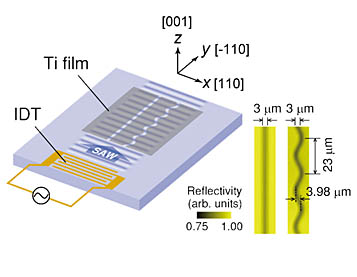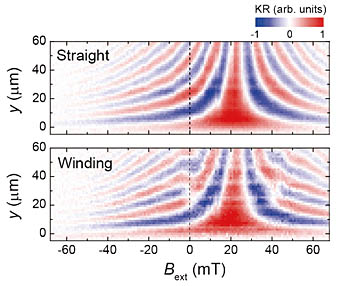Magnetic-Field-Free Electron Spin Resonance
Optical Science Laboratory, *Physical Science Laboratory
The most promising method of quantum information processing
with electron spins is based on electron spin resonance (ESR), a technique
commonly used both in research and for practical applications. However,
the previously proposed spin manipulation methods require external magnetic
fields, which are generated in spaces that greatly exceed the size of individual
electrons, thus making these complex and inefficient techniques unsuitable
for device applications. Here we demonstrate magnetic-field-free ESR achieved
by using spin-orbit effective magnetic fields (BSO) [1].
The sample was an undoped 20-nm-thick GaAs/AlGaAs (001) quantum well (Fig. 1). A surface acoustic wave (SAW) beam generated by an interdigital transducer (IDT) produces an array of potential wires that move along y (|| [-110]) with a velocity of 2.97 km/s. A Ti film with 3-µm-wide slits deposited on the wafer partially screens the piezoelectric field and produces moving dots that travel along the channels formed beneath the slits. We performed Kerr microscopy to investigate spin transport along a straight and winding channels, the latter of which was designed to be close to the resonance condition. A circularly polarized pump light generates spin polarized electrons at certain position (y = 0) on the channels and linearly polarized light probes the Kerr rotation, which is proportional to the spin density at the probe position [2]. The sample was placed in an electro-magnet that generated a magnetic field (Bext) along [110].
Figure 2 shows Kerr signals as a function of y and Bext for the two channels. The oscillations observed for the straight channel
are attributed to the spin precession induced by static magnetic fields.
The effects induced by an oscillating spin-orbit field appear in the data
for the winding channel; the precession phases show peculiar features at
around Bext = 0 and 46 mT. The Bloch simulations under BSO well reproduce the experimental results, and this proves the feasibility of the magnetic-field-free ESR. The technique will provide an efficient and flexible approach for the coherent control of flying spin information in solid-state devices.
This work was supported by KAKENHI.
[1] H. Sanada et al., Nature Physics 9 (2013) 280.
[2] H. Sanada et al., Phys. Rev. Lett. 106 (2011) 216602.
 |
 |
|||||
|
|